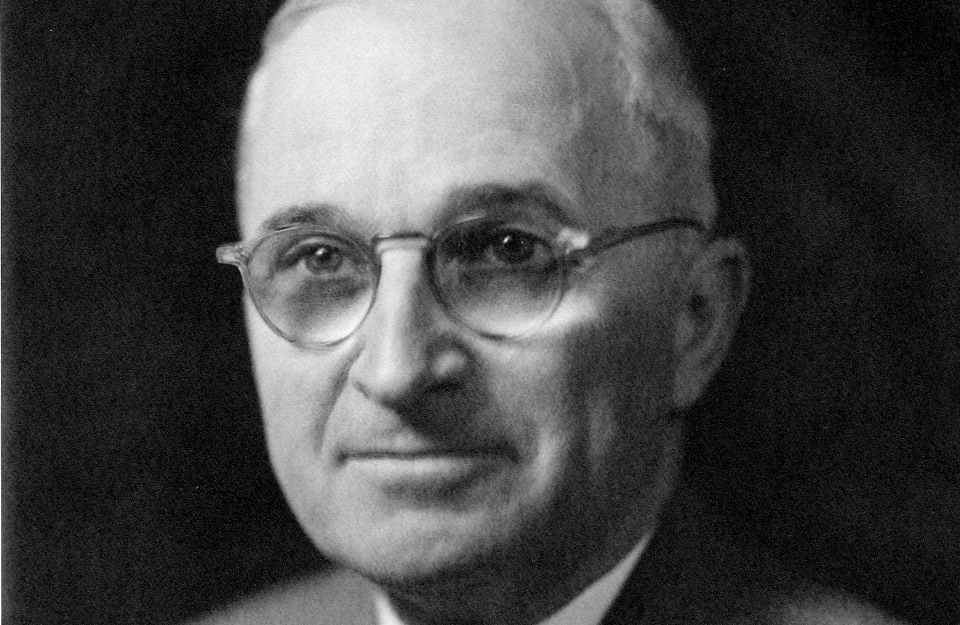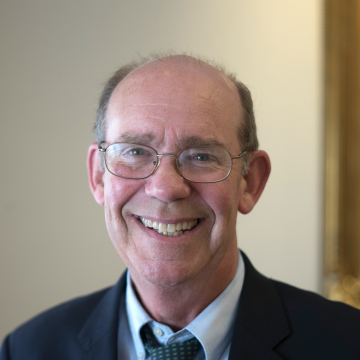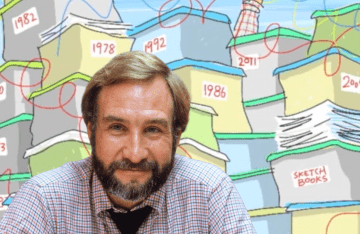The television and the President
On this day in 1947, Harry Truman delivered the first televised presidential speech. Communications expert David Eisenhower looks at the history of politics and media and the significance of this moment 75 years later.

Portrait of President Harry S. Truman (Photo Credit: National Archives / Leo G. Hessler, Jr.)
“The situation in Europe is grim and forbidding as winter approaches,” said President Harry Truman on Oct. 5, 1947. “The tragedy of hunger is a stark reality.”
In the first televised presidential speech, Truman implored his audience to cut back on grain to support a war-ravaged Europe. He called this a contribution to a just and lasting peace. “I am confident we will have the support of every American,” Truman said.

At the time, only about 44,000 U.S. households had a television set. “This was an experiment,” says David Eisenhower, director of the Institute for Public Service and a lecturer in the Annenberg School for Communication. “It was really not an effort to reach the American people directly by way of television but a way to reach them by way of news reports and radio broadcast.”
Within five years of this address, almost 17 million households had televisions—three out of every five families. Between 1947 and 1952, “America wired itself for television,” Eisenhower says.
On the 75th anniversary of the first televised presidential speech, Penn Today spoke with Eisenhower about the significance of this moment and the history of politics and media.
Q. During that speech, Truman asked Americans to cut back on their use of grain to help starving Europeans. That kind of sacrificial ask might have been familiar to Americans after the rationing of food during World War II, but how would that go over today?
Presidents don’t ask for our sacrifice much these days, and so that’s sort of terra incognita. I think people would be surprised.
I can remember after 9/11 my office was filled with Penn seniors, who were dropping by to ask my advice on what they could do. Yet George W. Bush had not asked the American people to do anything other than carry on with their lives. He asked them to support what he was going to do as president, but there was no ask there. I was struck by how urgently students wanted to respond.
Penn students are good at asking for opportunities. They’re not shy about it, and that’s something students seem to know about the outside world. The question is, What happens when the outside world asks us? I think it works both ways. In a nutshell, I think we would respond.
Recently, we have seen Americans accepting certain austerities because of the war in Ukraine. I think the war has muted issues that would otherwise be very telling against the administration: high gas prices and inflation. In an indirect way, right now we’re operating under an ask by a president to suspend judgment on the economy while we pass through this international crisis. That’s not as direct as Harry Truman in 1947 inaugurating a whole new era of television.
Q: For you personally, what has been the most memorable or significant televised speech?
The most complicated speech that I’ve ever seen delivered from the Oval Office was on March 31, 1968, when Lyndon B. Johnson stunned the world by announcing that he would not run for reelection. That threw the Democratic Party nomination open. He coupled this with a new policy announcement in Vietnam; the Tet Offensive had happened several weeks before this speech, calling every premise of Johnson’s policy into question. He had to simultaneously position himself in the 1968 campaign and announce the new force in Vietnam.
That is a fascinating speech because by withdrawing from the 1968 race he greatly enhanced his power, which is counterintuitive. Generally, when a president withdraws from the fray, he becomes a lame duck. That speech is not only a shock but an amazing thing to watch.
By far, the most studied speech in the National Archives and Records Administration System was Nixon’s silent majority speech of 1969, which coined a term that has lived on in American politics, the silent majority. I was in the adjoining room when the speech was being drafted, but I did not know that at the time. And it was a very far-reaching address, which I think underscores the importance that presidents attached to communications that emanate from the Oval Office. By drawing a line between a silent majority and the dissent in the Vietnam era, Nixon knew that he was crossing a Rubicon.
Q: In terms of content, what are the different kinds of televised presidential speeches delivered from the White House?
One category is the chief executive trying to carry out the law. This genre really begins with Dwight Eisenhower [his grandfather] announcing in the fall of 1957 that he is sending the 101st Airborne to Little Rock, Arkansas, to carry out the desegregation orders of Central High School by the district court. Eisenhower’s objective is to gain compliance with the court’s decision. His televised appeal is fashioned as an order to the citizens of Little Rock to cease and desist from rioting, accept the presence of the 101st Airborne, and carry out the court orders in an orderly manner.
Disasters are another category, like the Challenger disaster of 1986. George W. Bush gave a very underrated 9/11 speech, where he addresses the American people from the Oval Office. We had debates about it here at the Annenberg School. Many people felt that he was ineffective; Bush himself thought he was ineffective. But my question was, If this isn’t effective, how come his approval shot up to about 84%?
I remember watching it and thinking to myself—as I thought watching Challenger—this is a very disturbing moment. I take solace from our presidents who have responded to those moments. That’s a good use of the Oval Office.
Finally, I would say great initiatives; Lyndon Johnson, March 31, 1968, is a good example. Not only does he lay out a new policy in Vietnam, but he really stakes out a new basis for his authority, not as somebody who might be a future president but somebody who has no stake, no objective except bringing about some kind of peace in Vietnam. In other words, he elevates himself above the partisan fray and tries to take command of the Vietnam issue, which he does successfully in the speech.
Another example of a policy speech with impact would be Ronald Reagan’s Star Wars speech, which was delivered from the Oval Office. You can debate whether there was a serious program there—it was certainly a research and development program—but it is probably the speech that had more to do with bringing the Cold War to a close than any other he delivered. It completely rearranged the decks in strategic thinking between the Americans and Soviets. It called the nuclear bluff of the era. It really set us on a different course with the USSR without involving Congress.
Q: What image do the American people expect presidential candidates to project and how has television changed that?
I don’t think that there is a single physical image that matters. I don’t buy the idea that one size fits all. Television is not pushing us in the direction of an idealized candidate, no more than any other medium. Image is a function of looks, but above all it’s issue identification. The ability to identify with an audience or their association with issues.
A wide variety of types of people become public figures. What it all adds up to is character noteworthiness. One thing that media accomplishes is it can make an individual memorable. Why does one public figure become more famous than another? What differentiates the one from the thousands? Being memorable and having a certain savvy.
Media communication requires you to be succinct. ‘The soundbite’ is a way of putting it. This bothers a lot of would-be candidates who want to talk extensively about policy.
Two great communicators a century ago were Theodore Roosevelt and Woodrow Wilson. I don’t think that there were two more remarkable orators in American history, judged by text, and the delivered speeches go on for pages of very elaborately organized, single-spaced text.
Compare that with a contemporary acceptance speech or even a State of the Union speech. Generally, it’s two short lines, break for applause, two short lines, break for applause. The requirement of succinctness and brevity—and less formality—has obviously been a consequence of electronic communications.
Q: What is the future of presidential communication now that everyone has a device and television ratings keep dropping? And how does former President Trump’s Twitter use fit in
He was an innovator. Twitter was an innovation. We had papers on it. Another innovation would be John Kennedy holding a live press conference. You have to think hard to keep up with the art of catching attention. All I can say is that ratings are misleading. What politicians intend to communicate does get communicated and is heard. How that happens is a process of ever-growing complexity.
Television is a wonderful forum. Though it will be used less in the future because of the internet, I think it will always be used selectively to avoid overexposure, reserved for the most important matters. Now, televised images are becoming more decentralized. People are sitting with a device in bed, scrolling through the internet, so I don’t know how large an audience a president can command today.
When Eisenhower addressed the public on Little Rock, he was pre-empting coverage on all three networks. He had a monopoly over the national audience. There’s no medium today with that monopoly. People pick and choose what they want to hear. But the word gets out. The question is not whether it gets out but how. Since the stakes are so high, we can rely on people to devise ways to reach the American public.
Who knows what lies around the corner? It’s entirely possible that this dramatic method pioneered by presidents in the late 1950s and ’60s and ’70s is a tool available to the president, and we may need it again, as we may need again the sacrificial appeal that Harry Truman issued on national television in October 1947. He asked Americans to alter their daily routine to sacrifice on behalf of others; we may need that message again. And we may need television to deliver it.
David Eisenhower is the grandson of Dwight Eisenhower and the son-in-law of Richard Nixon.



